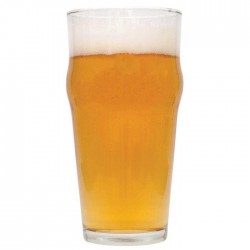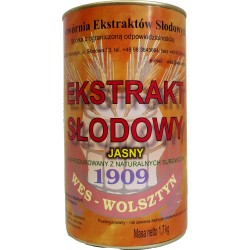Are you considering making a beer, but mashing still seems to be too difficult a process? Prepare a beer from malt extracts - you will not be disappointed with the result, and this is a big step towards mashing!
What do you need to make malt extract wort?
To prepare your malt wort, you will need a few accessories:
- a pot - ideally it should have a volume of 10-15 liters, but a smaller pot such as 5-8 liters will also work, but then you will probably need to boil some of the extract in the second round (without hopping),
- fermenter with a fermentation tube with a capacity of about 30 liters - needed for fermentation,
- Stirring paddle - used to stir the boiling extract,
- brewing thermometer,
- hop sock / hop tube / muslin hop boiling bag- one of these will prevent the hops from floating freely inside the fermenter, thus avoiding the need to filter the wort after boiling the hops (which is more time consuming). Too many hops in the fermentation bucket can adversely affect the taste of the beer and in the worst case can even lead to contamination of the beverage,
- disinfectant - one of the most popular and affordable agents is OXI.
You will also not do without raw materials. Here it will be necessary:
- malt extracts - for preparing a 23 liter brew you will use roughly 3-5 kilograms of extract, with 1 kilogram of extract giving us a BLG of 8° for 10 liters of wort. 3 kilos of malt extract used for a 23 liter brew will give us a BLG of 10°, while 5 kilos of extract will give us just over 16° BLG,
- hops - to calculate the amount of hops you can use our calculator. You can also buy a ready-made set of malt extracts in our store where we have calculated exactly the amount of hops to achieve the desired bitterness for a given style and prepared a detailed recipe,
- additives (optional) - there are many possibilities here, because you can use them during mashing (for example flowers, plants, lactose, stems, etc.) - they will influence the taste and aroma of beer. You can also think about additives that you will use only during the silent fermentation (e.g. fruit pulps, aromatic hops),
- Water - here you can use tap water or the cheapest market water in 5 liter cans. As for tap water - in some cases you can use "raw" water but it's advisable to boil it first.
- Yeast - you have to choose it yourself. Strains for particular styles from our kits are suggested on our website.
How to prepare beer from malt extracts?
1. Pour several liters of water into the pot, preferably about 5-8 liters. While the water is heating, place the malt extracts in another pot of hot water for about 10 minutes. This will soften the malt "syrup", making it easier to pour into the pot.
2. When the water is hot (not necessarily boiling), pour the malt extracts into the pot. Be sure to stir vigorously while adding the extracts. This will prevent the malt syrup from sticking to the bottom of the pot, which could result in scorching.
3. When the extracts are thoroughly mixed with the water, bring the mixture to a boil.
4. When the water has come to a boil go on to hopping - depending on the style add the appropriate amount of hops. You can add the hops at different intervals. The boil time from the moment you add the first hop should be around 60 minutes and throughout this time you can add hops in different proportions to achieve a different effect (hops added at 60 minutes are designed to introduce bitterness to the beer whereas if you add them at the last 10 minutes of boiling time they will give you less bitterness but more flavour). It's a good idea to use one of the elements used for hop filtration.
5. After 60 minutes of boiling, separate the hops from the rest of the wort, and pour the wort into a fermentation bucket. On the wall of the fermentation bucket there should be a scale indicating how many liters of liquid you have in your fermenter. It should indicate about 7-12 liters of wort (depending on how much water you had in the fermenter to begin with). This value can of course be higher or lower - it shouldn't affect the taste of the beer.
6. Add the previously prepared, preferably cold water to the hot wort inside the fermenter, so that there is about 23 liters of liquid in the fermenter. Adding cold water will cool the wort down, which will have a positive effect on the beer's later taste. Stir the wort thoroughly.
7. When the temperature of the wort reaches the temperature recommended for the yeast assignment by the manufacturer (you'll find it on the yeast package), add the yeast. You can sprinkle it on the surface of the wort or hydrate it beforehand. Seal the fermenter tightly after pitching. Pour water into the fermentation tube to prevent any unwanted objects (e.g. fruit flies) from getting inside the fermenter.
* IMPORTANT - remember to disinfect any equipment that will come into contact with the wort and pay special attention to the fermenter before pouring the wort into it.
After fermentation pour the beer into bottles using fermenting agents, it can be glucose or sugar. During the silent fermentation you can use the previously mentioned additives.

























Dodaj komentarz
0 komentarze